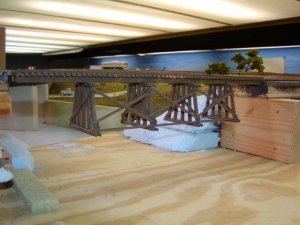Gus, fluorescent tubes come in many different colour temperature ranges. My first layout used four foot, double tube fixtures, mounted below a suspended ceiling. The tubes were "balanced" for colour photography. Regular fluorescent tubes will give a greenish cast to photos, while this type allows to use of regular "daylight" colour film. This was some time ago, but as best I can recall, the temperature of the light, in degrees Kelvin, determines the quality of the light. While the light is quite pleasant, the quantity of light is significantly less than what you would get from a regular "Cool White" tube. The other disadvantage is the cost: I paid about $16.00 per tube about 20 or 25 years ago. These tubes are also harder to start than regular ones: I finally got to the point where I left them on 24 hours a day. My current layout uses four foot, double tube fixtures, mounted above a suspended ceiling. There are 16 fixtures in the layout room: when the second level is built, there'll be another 8 suspended below the upper deck, for lighting the layout now in place. I use "Cool White" tubes: while I'm not nuts about the quality of the light, these type give the most light for the wattage, and are cheap and readily available. I talked to the guy at Home Depot about light output, and light quality, explaining what I was going to use them for. He suggested that I buy two of each type that I thought might be suitable, take them home to try out, then bring back those that weren't suitable and exchange them for more of the type that I decided was best. I tried "Warm White", "Daylight", and possibly one other. While all had decent light quality, they simply didn't put out enough lumens for my liking.
If you have a digital camera, the quality of the light is not important, as the camera will compensate. Several people have commented on the well-done lighting of my layout, but all credit for that is due the camera. The camera will also compensate, up to a point, for low light, so it's best to go with the type you most "like the looks of".
One other disadvantage of fluorescent lighting is that the light is very "flat": you won't get distinct shadows (this can be good or bad, depending on what you're photographing), although I sometimes hang a 100 watt "trouble light" from the ceiling grid if I want shadow effects.
As for putting 6 fixtures on one circuit, it will depend what else is on that circuit, and of course on the Code in your particular area. In Ontario, the Electrical Code allows a combination of up to 12 light fixtures or receptacles per circuit.
Here are a couple of photos: the first was taken to show the bridge, but, as is often the case, a couple of extraneous items slipped in in the background. The clear acrylic sheet in the lighting panels is called "cracked ice", although there are other types available.
This one's just a random shot of the layout, showing how the camera compensates for the improper colour temperature of the fluorescent lights. (On my computer monitor, which has an almost non-existent "red" component to the colour shown, the pictures look very true to what a film camera would see: the same scene with a decidedly greenish cast.)
Wayne



 )
)


